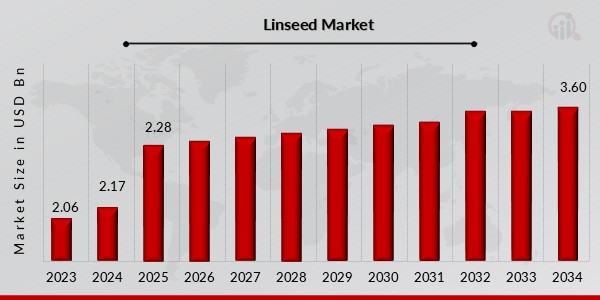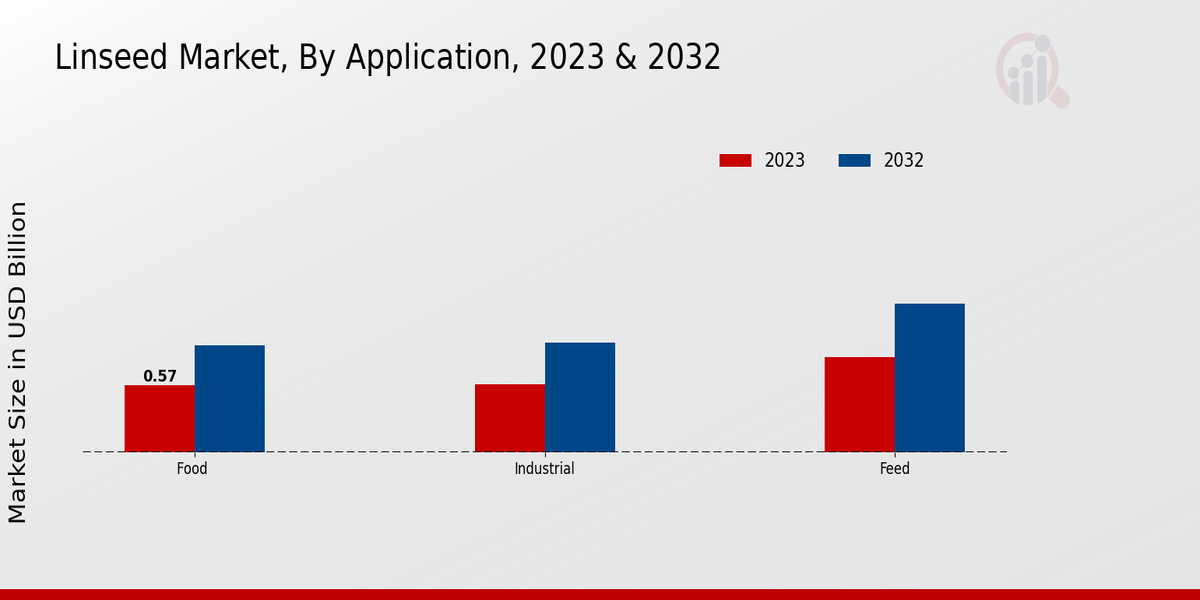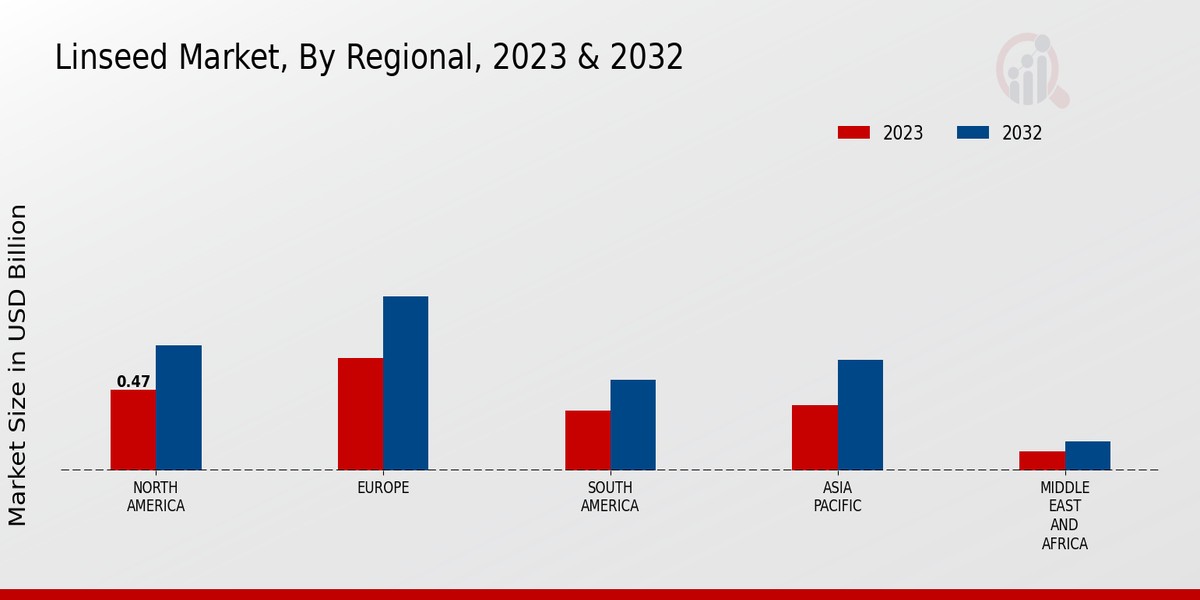Global Linseed Market Overview
Linseed Market Size was estimated at 2.17(USD Billion) in 2024. The Linseed Market Industry is expected to grow from 2.28 (USD Billion) in 2025 to 3.60 (USD Billion) by 2034. The Linseed Market CAGR (growth rate) is expected to be around 5.2% during the forecast period (2025 - 2034).

Source: Primary Research, Secondary Research, MRFR Database and Analyst Review
Key Linseed Market Trends Highlighted
The Linseed Market is anticipated to witness substantial growth, attributed to the burgeoning demand from various end-use industries, primarily in the food and beverage sector. The increasing awareness of the nutritional benefits of linseed in food products, such as its high fiber and omega-3 fatty acid content, is driving demand. Furthermore, the rising trend of vegan and gluten-free diets has boosted the market for linseed as a versatile and nutritious ingredient.Key market drivers include the growing popularity of plant-based diets, the rising use of linseed in functional foods and beverages, and the increasing demand for natural and organic products. Additionally, the growing acceptance of linseed in animal feed, particularly in poultry and aquaculture, is presenting lucrative opportunities for market growth.Recent trends indicate a shift towards sustainable and environmentally friendly farming practices, leading to increased demand for linseed as a rotational crop that improves soil health and reduces the need for synthetic fertilizers. The development of innovative technologies for extracting and refining linseed oil, along with the emergence of new applications in pharmaceuticals and cosmetics, are also shaping the market landscape.
Linseed Market Drivers
Rising Demand for Plant-Based Products
The linseed market is primarily driven by the increasing demand for plant-based products, particularly in the food and beverage industry. Linseed, also known as flaxseed, is a rich source of essential fatty acids, protein, and fiber, making it a popular ingredient in various plant-based food products. As consumers become more health-conscious and seek alternatives to animal-based products, the demand for linseed-based products is expected to continue to rise, thereby propelling the growth of the linseed market.The versatility of linseed in food applications, such as bread, cereals, and baked goods, further contributes to its growing popularity. Moreover, the growing adoption of vegan and vegetarian diets is anticipated to drive the demand for linseed-based products, positively impacting market growth.
Expansion of the Nutraceutical Industry
The expansion of the nutraceutical industry is another key driver of the linseed market. Linseed is gaining significant traction in the nutraceutical sector due to its rich nutritional profile and potential health benefits. Linseed-derived ingredients, such as flaxseed oil and lignans, are widely used in dietary supplements and functional foods.
The nutraceutical industry is experiencing rapid growth as consumers seek natural and effective ways to improve their health and well-being. This growing demand for linseed-based nutraceutical products is expected to drive market expansion.
Technological Advancements in Linseed Processing
Technological advancements in linseed processing techniques are also contributing to the growth of the linseed market. The development of innovative technologies has enabled the efficient extraction and processing of linseed oil, meal, and other valuable components. These advancements have led to improved product quality, increased yields, and reduced production costs.
Additionally, technological innovations have facilitated the development of new linseed-based products, such as cold-pressed linseed oil and extruded linseed meal, which cater to specific consumer needs and market demands. The continuous improvement in linseed processing technologies is expected to further drive market growth.
Linseed Market Segment Insights
Linseed Market Application Insights
The Linseed Market is segmented by application into Food, Industrial, and Feed. The growth of the Food segment is attributed to the increasing demand for linseed oil and meals in the food industry. Linseed oil is a rich source of omega-3 fatty acids, which are essential for human health. Linseed meal is a high-protein ingredient that is used in the production of animal feed and pet food.
The Industrial segment is the second largest segment of the Linseed Market. This segment is expected to grow at a CAGR of 4.8% from 2023 to 2032. The growth of the Industrial segment is driven by the increasing demand for linseed oil in the production of paints, varnishes, and other industrial products.Linseed oil is also used in the production of linoleum, a type of flooring that is made from linseed oil and cork. The Feed segment is the smallest segment of the Linseed Market. This segment is expected to grow at a CAGR of 4.2% from 2023 to 2032. The growth of the Feed segment is driven by the increasing demand for linseed meal in the production of animal feed. The growth of the market is attributed to the increasing demand for linseed oil and meal in the food, industrial, and feed industries.

Source: Primary Research, Secondary Research, MRFR Database and Analyst Review
Linseed Market Process Type Insights
The Linseed Market segmentation by Process Type includes the Conventional Method and the Cold Press Method. The Conventional Method held the largest market share in 2023, and it is expected to continue its dominance throughout the forecast period. This method involves crushing linseed seeds using mechanical expellers or hydraulic presses to extract oil.
The Cold Press Method, on the other hand, is a more recent technique that uses a screw press to extract oil at low temperatures, preserving the oil's nutritional value and flavor. The Linseed Market revenue generated from the Cold Press Method is projected to grow at a faster rate during the forecast period, owing to increasing consumer demand for high-quality and minimally processed oils.
Linseed Market Variety Insights
Variety Segment Overview and Insights The linseed market is segmented based on variety into brown linseed, golden linseed, and other varieties. Brown linseed dominates the market, accounting for over 60% of the revenue in 2023. This dominance is attributed to its higher oil content and better nutritional profile compared to other varieties. Golden linseed, on the other hand, is gaining popularity due to its unique nutty flavor and higher fiber content. It is primarily used in specialty food products such as baked goods and breakfast cereals.Other varieties, including yellow and black linseed, account for a smaller share of the market but offer distinct characteristics and applications. The market for other varieties is expected to grow at a significant rate in the coming years, driven by increasing demand for specialty linseed products.
Linseed Market Grade Insights
The Linseed Market is segmented based on Grade into Organic, Conventional, and GMO. The Organic segment is projected to witness significant growth over the forecast period due to the increasing demand for organic food products. Consumers are becoming more health-conscious and are willing to pay a premium for organic products that are perceived to be healthier and more environmentally friendly. The Conventional segment is expected to hold a major share of the market due to its widespread availability and lower cost compared to organic linseed.The GMO segment is expected to experience moderate growth as consumers become more aware of the potential benefits and safety of GMOs. In 2023, the Organic segment accounted for 32.5% of the Linseed Market revenue, which is expected to reach 40.5% by 2032.
The Conventional segment is anticipated to reach 55% of the market share by 2032. The GMO segment is expected to reach 14.5% of the market share by 2032. These insights are crucial for businesses operating in the Linseed Market as they can help them tailor their strategies to target specific segments and capitalize on growth opportunities.
Linseed Market Packaging Type Insights
Packaging Type Segment Overview Packaging plays a crucial role in preserving the quality and extending the shelf life of linseed. The Linseed Market is segmented into bulk packaging and retail packaging based on packaging type. Bulk packaging involves storing linseed in large containers, such as bags or sacks, primarily used by industrial consumers and manufacturers.
Retail packaging, on the other hand, caters to individual consumers and typically includes smaller-sized packaging options like pouches or boxes. In 2023, the bulk packaging segment accounted for a significant share of the Linseed Market revenue due to its cost-effectiveness and suitability for large-scale distribution.However, the retail packaging segment is projected to grow at a higher CAGR during the forecast period (2023-2032) driven by the increasing demand for convenient and branded linseed products among consumers. As a result, manufacturers are focusing on developing innovative retail packaging solutions to meet evolving consumer preferences and enhance product differentiation.
Linseed Market Regional Insights
The regional segmentation of the Linseed Market offers insights into the market's geographic distribution and growth patterns. North America, Europe, APAC, South America, and MEA are the key regions analyzed in this segment. In 2023, North America held a significant share of the Linseed Market revenue, driven by increasing demand for linseed oil in various industries.
Europe is another prominent region with a growing market for linseed-based products such as bread, cereals, and supplements. The APAC region is expected to witness significant growth in the coming years, owing to rising health consciousness and increasing disposable income.South America and MEA also represent potential markets for linseed products, with growing demand from the food and beverage industry.

Source: Primary Research, Secondary Research, MRFR Database and Analyst Review
Linseed Market Key Players And Competitive Insights
Major players in the Linseed Market industry are constantly improving their production methods and technologies to maintain their competitive edge. Leading Linseed Market players are investing in research and development to introduce innovative products that meet the evolving demands of customers. The Linseed Market development is also driven by the increasing demand for plant-based products and the growing awareness of the health benefits associated with linseed. As a result, the Linseed Market Competitive Landscape is expected to remain highly competitive in the coming years.A notable competitor in the Linseed Market is Archer Daniels Midland Company, a leader in agricultural commodities and food ingredients. The company has a strong presence in the Linseed Market and offers a wide range of linseed products. Archer Daniels Midland Company is known for its commitment to quality and innovation, and it continuously invests in research and development to improve its products and processes. The company's reach and extensive distribution network enable it to meet the needs of customers worldwide.Another key competitor in the Linseed Market is Cargill, Incorporated, a leading provider of agricultural products and services. Cargill has a significant presence in the Linseed Market and offers a comprehensive range of linseed products. The company is focused on sustainability and ethical sourcing, and it works closely with farmers to ensure the quality and traceability of its products. Cargill's network and strong relationships with suppliers enable it to meet the diverse needs of customers in various regions.
Key Companies in the Linseed Market Include
- Linseed Oil International
- ADM
- A.T.T.A.
- All About Seeds Ltd.
- Flaxman Pty Ltd
- Hills Mills
- North American Millers' Association
- Lintbells Group
- Dunavant
- BRAX AG
- SGS India Pvt. Ltd
- CanMar Foods
- Richardson Oilseed
- Miller Milling Company
- Golden Valley Organic Oils
Linseed Market Industry Developments
The linseed market is projected to grow from USD 1.96 billion in 2023 to USD 3.1 billion by 2032, at a CAGR of 5.22% during the forecast period. The market is driven by the rising demand for linseed-based products in various end-use industries, including food, feed, and pharmaceuticals. The growing awareness of the health benefits associated with linseed consumption, such as improved cardiovascular health, reduced inflammation, and weight management, is also contributing to the market growth.
The increasing adoption of vegan and gluten-free diets is further fueling the demand for linseed-based products. Key market players are focusing on expanding their production capacities and introducing innovative products to cater to the growing demand. Recent news developments include the launch of new linseed-based food products by major food brands and collaborations between market players to strengthen their distribution networks.
Linseed Market Segmentation Insights
Linseed Market Application Outlook
- Food (Oil, Flour, and Linseed Meal)
- Industrial (Paint, Linoleum, and Others)
- Feed
Linseed Market Process Type Outlook
- Conventional Method
- Cold Press Method
Linseed Market Variety Outlook
- Brown Linseed
- Golden Linseed
- Other Varieties
Linseed Market Grade Outlook
Linseed Market Packaging Type Outlook
- Bulk Packaging
- Retail Packaging
Linseed Market Regional Outlook
- North America
- Europe
- South America
- Asia Pacific
- Middle East and Africa
| Report Attribute/Metric |
Details |
| Market Size 2024 |
2.17 (USD Billion) |
| Market Size 2025 |
2.28 (USD Billion) |
| Market Size 2034 |
3.60 (USD Billion) |
| Compound Annual Growth Rate (CAGR) |
5.2% (2024 - 2032) |
| Report Coverage |
Revenue Forecast, Competitive Landscape, Growth Factors, and Trends |
| Base Year |
2023 |
| Market Forecast Period |
2025 - 2034 |
| Historical Data |
2019 - 2023 |
| Market Forecast Units |
USD Billion |
| Key Companies Profiled |
Linseed Oil International, ADM, S.A.T.T.A., Ally About Seeds Ltd., Flaxman Pty Ltd, Hills Mills, North American Millers' Association, Lintbells Group, Dunavant, BRAX AG, SGS India Pvt. Ltd, CanMar Foods, Richardson Oilseed, Miller Milling Company, Golden Valley Organic Oils |
| Segments Covered |
Application, Process Type, Variety, Grade, Packaging Type, Regional |
| Key Market Opportunities |
1 Increasing demand for vegan food and beverages2 Growing awareness of nutritional benefits3 Expansion in enduse industries4 Technological advancements in processing5 Government incentives for sustainable farming |
| Key Market Dynamics |
1 Increasing demand for plant-based foods2 Growing awareness of health benefits3 Rising disposable incomes in emerging economies4 Technological advancements in oil extraction processes5 Expansion of the livestock industry |
| Countries Covered |
North America, Europe, APAC, South America, MEA |
Frequently Asked Questions (FAQ) :
The Linseed Market is projected to reach an overall valuation of approximately 2.17Billion USD in 2024.
The Linseed Market is anticipated to reach an overall valuation of approximately 3.60 Billion USD by 2034.
The Linseed Market is projected to register a CAGR of approximately 5.2% from 2023 to 2034.
The Asia-Pacific region is anticipated to hold the largest market share in the Linseed Market, driven by factors such as growing demand for linseed oil in food and industrial applications in countries like India and China.
Linseed finds applications in various industries, including food, pharmaceuticals, cosmetics, and animal feed. In the food industry, linseed is used as an ingredient in bread, cereals, and other products. In pharmaceuticals, linseed oil is used as a source of essential fatty acids and in cosmetics, it is used as an emollient and moisturizer.
Major players in the Linseed Market include companies such as Archer Daniels Midland Company, Cargill, Incorporated, Bunge Limited, and Ag Processing Inc. These companies are involved in the production, processing, and distribution of linseed and its derivatives.
The Linseed Market faces challenges such as fluctuating raw material prices, weather conditions affecting crop yields, and competition from other oilseed crops. Additionally, regulatory changes and trade policies can also impact the market dynamics.
The Linseed Market presents opportunities for growth due to rising demand for plant-based products, increasing awareness of the health benefits of linseed, and expanding applications in various industries. Technological advancements in processing and extraction techniques can further drive market growth.
The Linseed Market is segmented based on product type (brown linseed, golden linseed, and others), application (food, pharmaceuticals, cosmetics, animal feed, and others), and geography (North America, Europe, Asia-Pacific, South America, and Middle East & Africa).
Recent trends in the Linseed Market include a growing focus on sustainable and organic production practices, increasing demand for non-GMO linseed, and the development of new value-added products such as linseed protein concentrates and dietary supplements.

















